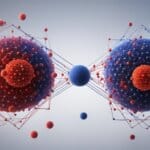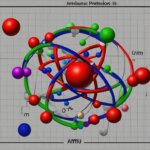Table of Contents
Welcome to our exploration of quantum theory, a fascinating field that delves into the nature of matter and energy at the atomic and subatomic level. Quantum theory, also known as quantum physics or quantum mechanics, provides profound insights into the fundamental principles that govern particles and waves.
Quantum theory has revolutionized our understanding of the universe and has paved the way for groundbreaking technological advancements. From quantum computing to quantum cryptography, the applications of this theory have the potential to reshape various industries.
In this article, we will delve into the development of quantum theory, the key concepts it encompasses, and its impact on technology. Are you ready to unravel the mysteries of the quantum realm? Let’s dive in!
In the following sections, we will explore the historical background of quantum theory, including the groundbreaking contributions of scientists like Max Planck, Albert Einstein, and Niels Bohr. We will delve into concepts such as wave-particle duality, quantum entanglement, and the uncertainty principle.
We will also discuss the Copenhagen interpretation, which examines the question of objective reality in quantum mechanics, and the intriguing many-worlds theory, which proposes the existence of parallel universes.
Furthermore, we will explore the significance of quantum states and wavefunctions in understanding particle behavior. We will uncover the phenomenon of quantum tunneling and its applications in various fields, including nuclear fusion and electronics.
Finally, we will dive into the impact of quantum mechanics on technology, exploring the realms of quantum computing, quantum cryptography, and quantum sensors. The potential of these advancements to transform industries cannot be overstated.
Get ready to embark on an extraordinary journey through the quantum realm. Understanding quantum theory is an essential step towards comprehending the very fabric of our universe and unlocking the unlimited possibilities it holds.
The Development of Quantum Theory
In the early 20th century, physicist Max Planck introduced quantum theory by suggesting that energy existed in discretely quantized units, called quanta. This concept challenged the previous understanding that energy was solely a continuous wave. Later, scientists like Albert Einstein and Louis de Broglie further contributed to the development of quantum theory.
Wave-Particle Duality:
Albert Einstein’s proposition of wave-particle duality revolutionized our understanding of the behavior of particles. According to this principle, particles such as electrons and photons can exhibit both wave-like and particle-like properties, depending on how they are observed and measured.
The Uncertainty Principle:
Werner Heisenberg’s uncertainty principle added another layer to quantum theory. The principle states that it is impossible to simultaneously measure certain complementary values of a particle with absolute precision. This fundamentally challenges our ability to predict and determine the exact properties of particles.
This significant progress in the development of quantum theory paved the way for a deeper understanding of the subatomic world, challenging classical physics and opening the door to new possibilities.
| Scientist | Contribution |
|---|---|
| Max Planck | Introduced the concept of energy quantization |
| Albert Einstein | Introduced the concept of wave-particle duality |
| Louis de Broglie | Proposed the wave nature of particles |
| Werner Heisenberg | Formulated the uncertainty principle |
The Copenhagen Interpretation and the Many-Worlds Theory
The Copenhagen interpretation, proposed by Niels Bohr, is a fundamental concept in quantum theory that challenges our understanding of reality. According to this interpretation, the properties of a particle are not fixed until they are measured. This implies that the act of observation influences the behavior and characteristics of the particle.
A key principle of the Copenhagen interpretation is superposition, which suggests that a particle can exist in multiple states simultaneously until it is observed or measured. This means that particles can be in a state of flux, existing in a combination of different possibilities. To illustrate this concept, physicist Erwin Schrödinger devised a famous thought experiment known as Schrödinger’s Cat.
In Schrödinger’s Cat thought experiment, a cat is placed in a closed box alongside a vial of poison. The release of the poison is determined by the decay of a radioactive particle. According to quantum theory, until the box is opened and the cat is observed, the cat would be both alive and dead simultaneously, existing in a superposition of states.
“The Copenhagen interpretation suggests that the nature of reality is probabilistic and that particles exist in a state of superposition until observed. It challenges the conventional notion of a fixed and objective reality.”
On the other hand, the many-worlds theory, developed by physicist Hugh Everett and further supported by Stephen Hawking and Richard Feynman, takes a different approach. It proposes that every event splits the universe into multiple parallel universes, each representing a different outcome. In this theory, all possible states and outcomes exist simultaneously in separate branches of reality.
The many-worlds theory posits that every time a measurement is made, the universe splits into multiple branches, with each branch containing different states or possibilities. This implies that there are infinitely many parallel universes coexisting with our own, each representing every possible outcome of a quantum event.
The Copenhagen interpretation and the many-worlds theory offer contrasting perspectives on the nature of reality and the behavior of particles. While the Copenhagen interpretation emphasizes the role of measurement and the collapse of the wavefunction, the many-worlds theory suggests the existence of a vast multiverse where all possible outcomes are realized.
Key Concepts of Quantum Mechanics
Quantum mechanics encompasses several key concepts that challenge our traditional understanding of the physical world. These concepts provide profound insights into the behavior of particles on the atomic and subatomic level, ultimately shaping our understanding of reality itself.
Wave-Particle Duality
Wave-particle duality is a fundamental concept in quantum mechanics, which states that particles can exhibit properties of both particles and waves. This means that particles, such as electrons and photons, can behave like waves under certain conditions, demonstrating interference and diffraction effects. However, they also exhibit particle-like behavior, with discrete quantities of energy and the ability to occupy distinct positions in space.
Superposition
Superposition is another key concept that sets quantum mechanics apart from classical physics. According to the principle of superposition, particles can exist in multiple states simultaneously until observed or measured. This means that a particle can simultaneously occupy different positions, have different velocities, or possess various properties until an observation collapses its wavefunction, yielding a specific value for a specific property.
Quantum Entanglement
Quantum entanglement is a phenomenon in which two or more particles become correlated in such a way that the state of one particle is dependent on the state of the others, regardless of the distance between them. When particles are entangled, they share a deep and mysterious connection that defies classical concepts of communication and interaction. Changes made to the properties of one entangled particle instantaneously affect the properties of the other entangled particles, even if they are light-years apart.
Uncertainty Principle
The uncertainty principle, formulated by Werner Heisenberg, states that it is impossible to simultaneously know the precise values of certain pairs of complementary properties of a particle. In other words, there is a fundamental limit to our ability to measure certain physical quantities accurately. This principle deals with the inherent uncertainty in obtaining simultaneous measurements of properties such as position and momentum, or energy and time.
These key concepts of quantum mechanics fundamentally reshape our understanding of reality and the behavior of matter and energy at a fundamental level. They challenge long-held classical notions and have significant implications for the development of technologies such as quantum computing, quantum cryptography, and quantum sensors.
In the next section, we will delve into the quantum states and wavefunctions, which provide the mathematical framework for understanding the probabilistic nature of particles in quantum mechanics.
Quantum States and Wavefunctions
In the realm of quantum mechanics, particles are described by wavefunctions, which represent the probability amplitudes of different quantum states. These wavefunctions provide valuable insight into the behavior of particles on the atomic and subatomic level. They offer a probabilistic framework for understanding the complex nature of quantum phenomena.
Wavefunctions are not static but evolve over time in accordance with Schrödinger’s equation. This equation, named after the Austrian physicist Erwin Schrödinger, mathematically describes how wavefunctions change and predict the future behavior of quantum systems. Through the analysis of wavefunctions, scientists can make predictions about the probabilities of different outcomes in quantum experiments.
The concept of quantum states, determined by the wavefunctions, is fundamental to understanding quantum mechanics. Quantum states encompass the various possible configurations that a particle can exist in. These configurations are associated with specific properties and behaviors of the particle. By studying the wavefunctions and their corresponding quantum states, scientists gain insight into the probabilities of a particle’s behavior and outcomes.
Table: Example Probability Amplitudes of Quantum States
| Quantum State | Probability Amplitude |
|---|---|
| Ground State | 0.707 |
| Excited State | 0.354 |
| Superposition | 0.5 |
The table above illustrates the probability amplitudes associated with different quantum states. The ground state has a probability amplitude of 0.707, indicating a higher likelihood of the particle being in that state. The excited state has a lower probability amplitude of 0.354, suggesting a lower chance of the particle occupying that state. In the case of a superposition, where the particle exists in a combination of states, the probability amplitude is 0.5, implying an equal chance of observing either state.
Understanding quantum states and wavefunctions is crucial for comprehending the behavior and predictions of particles in quantum systems. These concepts form the foundation of quantum mechanics and pave the way for innovative technologies such as quantum computing, quantum cryptography, and more.

Quantum Tunneling and Its Significance
Quantum tunneling is a fascinating phenomenon in which particles can pass through energy barriers that would be considered insurmountable in classical physics. This concept challenges traditional notions of particle behavior and holds great significance in various processes, including nuclear fusion and the operation of tunnel diodes in electronics.
When particles encounter an energy barrier, such as a potential barrier, they don’t necessarily bounce back or get completely blocked. Instead, due to the principles of quantum mechanics, there is a small but finite probability for particles to “tunnel” through the barrier and come out on the other side.
This phenomenon of quantum tunneling plays a crucial role in nuclear fusion, the process that powers the sun and other stars. In nuclear fusion, atomic nuclei overcome the repulsive forces between them through quantum tunneling, allowing them to get close enough for the strong nuclear force to bind them together, releasing a tremendous amount of energy in the process.
Quantum tunneling also finds practical applications in the field of electronics, particularly in the operation of tunnel diodes. A tunnel diode is a specialized semiconductor device that takes advantage of quantum tunneling to create a unique current-voltage characteristic. This enables them to operate in a way that conventional diodes cannot, making them useful in various electronic circuits and applications.
Overall, quantum tunneling is a fundamental concept that defies classical physics’ limitations, opening up new possibilities in energy production and electronic devices. Its understanding and application have revolutionized our understanding of particle behavior and continue to shape technological advancements in numerous fields.
Quantum Tunneling in a Nutshell
| Key Points | Significance |
|---|---|
| Particles can pass through energy barriers that would be considered insurmountable in classical physics. | Challenges traditional notions of particle behavior and expands our understanding of fundamental physics. |
| Crucial in processes such as nuclear fusion and the operation of tunnel diodes in electronics. | Allows for energy production and the development of advanced electronic devices. |
| Enables nuclear fusion by overcoming the repulsive forces between atomic nuclei. | Facilitates the production of massive amounts of energy, powering stars. |
| Utilized in tunnel diodes to create unique current-voltage characteristics. | Enables specialized electronic circuits and applications. |
Quantum Mechanics and Technological Advancements
Quantum mechanics, with its profound understanding of the behavior of particles on the atomic and subatomic level, has sparked a technological revolution. Its applications in quantum computing, quantum cryptography, and quantum sensors are reshaping various industries, including finance and medicine. The power of quantum mechanics lies in its ability to solve complex problems that classical computers struggle to solve.
Quantum computing, a field that harnesses the principles of quantum mechanics, offers the potential for exponential computational speed and the ability to solve problems that are currently intractable. Quantum computers, such as those being developed by companies like IBM and Google, rely on the unique properties of quantum bits or qubits, which can exist in multiple states simultaneously. This parallel processing capability allows for the exploration of a vast number of possibilities simultaneously, enabling faster and more efficient problem-solving.
Quantum cryptography, another groundbreaking application of quantum mechanics, aims to secure communications by utilizing the principles of quantum physics. Traditional cryptographic methods rely on complex mathematical algorithms, whereas quantum cryptography leverages the properties of quantum particles for secure information exchange. Quantum key distribution, for example, enables the secure sharing of encryption keys by exploiting the indeterminacy of quantum states.
Furthermore, quantum sensors, which utilize the delicate nature of quantum particles, have the potential to revolutionize sensing and measurement technologies. Quantum sensors can provide highly precise and sensitive measurements, making them invaluable in a wide range of fields, including healthcare, environmental monitoring, and navigation. For instance, quantum-based magnetic sensors can detect small changes in magnetic fields, enabling the development of more accurate medical imaging devices and navigation systems.
FAQ
What is quantum theory?
Quantum theory, also known as quantum physics or quantum mechanics, is a theoretical framework in modern physics that explains the nature and behavior of matter and energy on the atomic and subatomic level.
Who introduced quantum theory?
Physicist Max Planck introduced quantum theory by suggesting that energy existed in discretely quantized units called quanta.
What is wave-particle duality?
Wave-particle duality is the concept that particles can exhibit both particle-like and wave-like behavior.
What is the uncertainty principle?
The uncertainty principle, proposed by Werner Heisenberg, states that precise simultaneous measurement of certain complementary values of a particle is impossible.
What is the Copenhagen interpretation?
The Copenhagen interpretation, proposed by Niels Bohr, suggests that a particle’s properties are not defined until they are measured and that a particle can exist in multiple states simultaneously, known as superposition.
What is the many-worlds theory?
The many-worlds theory, supported by scientists like Stephen Hawking and Richard Feynman, posits that the universe splits into parallel universes representing each possible state of an object, allowing for interaction and affecting all possible states.
What is quantum tunneling?
Quantum tunneling is a phenomenon in which particles can pass through energy barriers that would be considered insurmountable in classical physics.
What are quantum states and wavefunctions?
Quantum states, determined by wavefunctions, represent the probability amplitudes of different states and provide a probabilistic framework for understanding particle behavior.
What is the significance of quantum mechanics in technology?
Quantum mechanics has revolutionized technology and led to the development of quantum computing, quantum cryptography, and quantum sensors, with the potential to transform industries such as finance and medicine.







